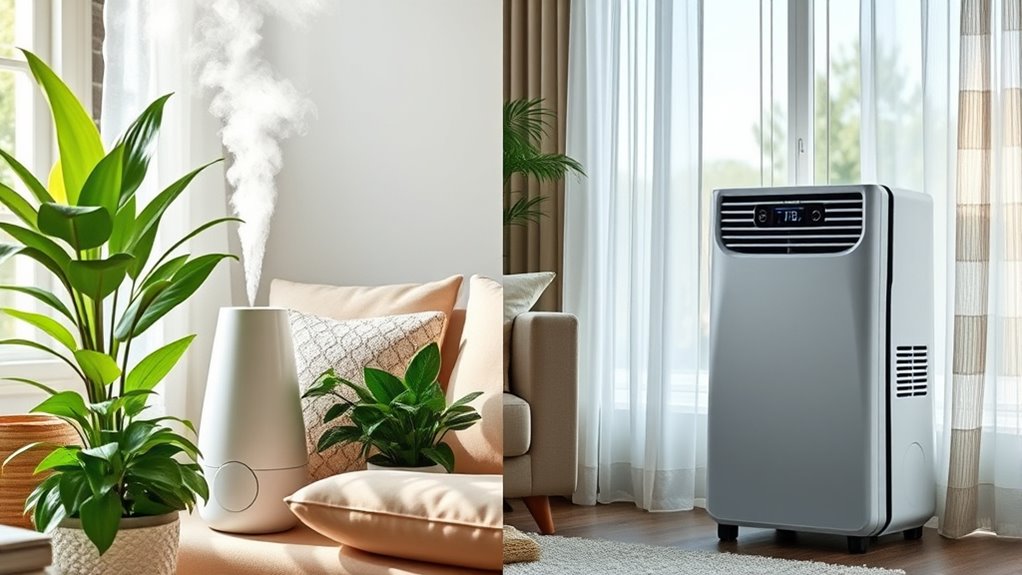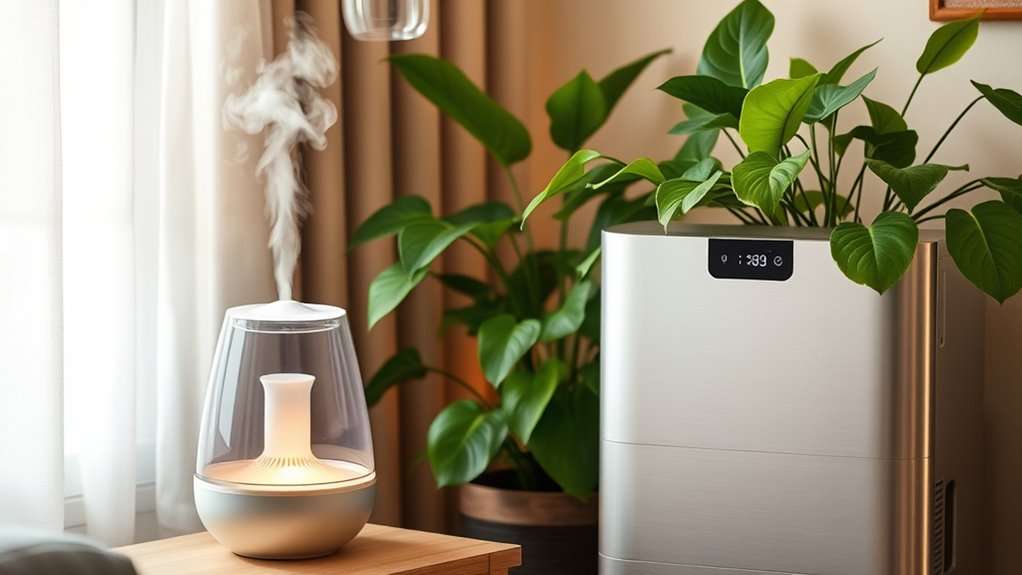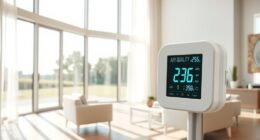If your indoor air is dry, especially in winter, I recommend using a humidifier to add moisture and improve comfort. On the other hand, if your environment feels damp, moldy, or you notice musty odors, a dehumidifier helps remove excess moisture and protect your home. Knowing when to use each device depends on your space’s humidity levels and conditions. Keep exploring to discover how to optimize your indoor air quality effectively.
Key Takeaways
- Use a humidifier in dry environments or winter to increase indoor humidity and improve comfort.
- Use a dehumidifier in damp areas or humid seasons to reduce moisture and prevent mold growth.
- Monitor humidity levels with a hygrometer to determine whether to add or remove moisture.
- Humidifiers help alleviate respiratory issues and skin dryness caused by dry air.
- Dehumidifiers protect against mold, dust mites, and property damage caused by excess moisture.

When it comes to maintaining a comfortable home environment, understanding the differences between humidifiers and dehumidifiers is crucial. These devices directly impact air quality, energy efficiency, and overall comfort, so knowing when and why to use each can save you money and improve your living space.
Humidifiers add moisture to the air, which is especially helpful during dry winter months or in homes with low humidity levels. When the air is too dry, it can cause skin irritation, respiratory discomfort, and even static electricity. I’ve noticed that using a humidifier helps me breathe easier and keeps my skin from feeling cracked and irritated. But beyond comfort, humidifiers also support better air quality. Proper humidity levels reduce airborne dust and allergens, making the environment healthier, particularly for allergy sufferers or those with respiratory issues.
Humidifiers improve air quality and comfort during dry winter months.
Energy efficiency is another factor to think about. Modern humidifiers are designed to consume minimal power, especially the ultrasonic models, which are quite energy-efficient. This means you can maintain a comfortable humidity level without substantially increasing your energy bills. However, it’s important to use them wisely. Over-humidifying can lead to mold growth and dust mites, which deteriorate air quality rather than improve it. I always monitor humidity levels with a hygrometer to ensure I keep it within the ideal range—around 30-50%. This not only protects my health but also keeps my energy consumption in check.
On the flip side, dehumidifiers remove excess moisture from the air, which is critical in damp environments or during humid seasons. When the air is too moist, it can promote mold growth, cause musty odors, and worsen respiratory conditions. I’ve used a dehumidifier in my basement to prevent mold and keep the air fresh. These devices are essential in maintaining good air quality by reducing humidity that can harbor mold spores and dust mites. Plus, they help protect furniture and walls from moisture damage. Additionally, proper maintenance of dehumidifiers ensures they operate efficiently and prolongs their lifespan.
In terms of energy efficiency, modern dehumidifiers are also quite effective, but they do consume more power than humidifiers since they work harder to remove moisture. It’s a good idea to run them only when necessary and keep humidity levels in check. I find that setting the device to a target humidity level and letting it do its job works best. This approach saves energy and ensures the air remains comfortable and healthy.
Ultimately, choosing between a humidifier or dehumidifier depends on your home’s specific needs. Both play essential roles in enhancing air quality and energy use, helping you create a healthier, more comfortable living space.
Frequently Asked Questions
Can Both Devices Be Used Simultaneously in the Same Room?
Yes, you can use both a humidifier and a dehumidifier in the same room, but it’s important to monitor humidity levels closely. If the devices aren’t compatible or set properly, they might work against each other, making it hard to maintain ideal humidity. I recommend using a hygrometer to keep track of humidity and adjust each device accordingly, ensuring they complement each other rather than conflict.
How Do I Choose the Right Size for My Space?
Ever wondered how to pick the right size for your space? I always start by measuring the room size and checking the device capacity. For small rooms, a compact humidifier or dehumidifier does the trick, while larger spaces need higher capacity models. Matching device capacity to your room size guarantees efficient operation and comfort. So, measure carefully and choose a device that’s rated for your space’s square footage.
Are There Health Risks Associated With Overusing These Devices?
Overusing humidifiers or dehumidifiers can pose health concerns and affect device safety. I always monitor humidity levels to prevent mold growth or respiratory issues caused by excessively high or low humidity. Proper maintenance, like cleaning filters regularly, is essential to keep devices safe and avoid mold or bacteria buildup. Using these devices responsibly helps guarantee a healthy environment and reduces any risks associated with overuse.
Do Energy Costs Differ Significantly Between Humidifiers and Dehumidifiers?
Have you ever wondered if energy expenses really differ between humidifiers and dehumidifiers? I’ve found that dehumidifiers tend to have higher operational costs because they run more frequently and use more power. Humidifiers generally consume less energy, making them more cost-effective for maintaining indoor moisture levels. So, if you’re watching your energy bills, choosing the right device based on operational costs can make a big difference in your monthly expenses.
How Often Should I Clean and Maintain Each Device?
I recommend cleaning your humidifier or dehumidifier at least once a month to guarantee ideal device lifespan and performance. For humidifiers, you should change the water daily and disinfect weekly to prevent mold. Dehumidifiers need filter checks and coil cleaning every few months. Regular maintenance prevents bacteria buildup, maintains efficiency, and extends the device’s lifespan. Keep a routine, and you’ll enjoy healthier, more effective operation.
Conclusion
So, whether you need a humidifier or a dehumidifier depends on your home’s moisture levels. Think of a humidifier as a cozy blanket adding warmth when it’s too dry, while a dehumidifier is like a fan clearing out dampness and mold. If you’re unsure, picture a room with cracked paint (too dry) versus a damp basement with musty walls (too wet). Choosing the right device keeps your home comfy and healthy.








